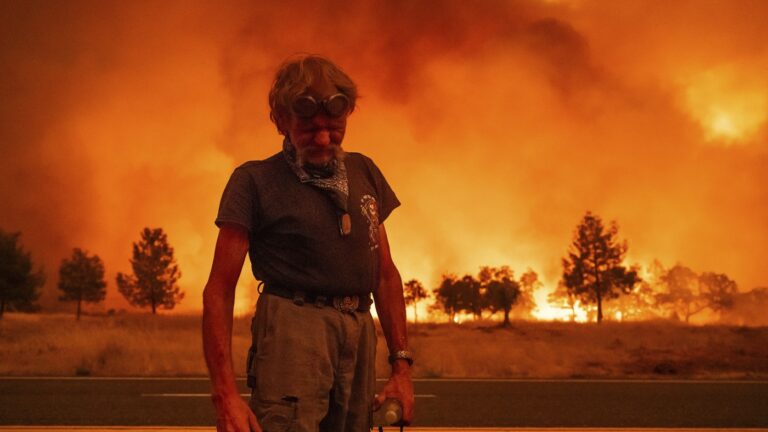
Grant Douglas pauses his evacuation Friday as the Park Fire crosses Highway 36 near Paynes Creek in Tehama County, California.
Noah Berger/AP
Hide caption
Toggle caption
Noah Berger/AP
FOREST RANCH, Calif. — Wildfires burning across the western U.S. and Canada, including the largest in California this year, led to air quality warnings for millions of people and thousands of firefighters battling the blazes on Sunday.
The so-called Park Fire had burned more than 550 square miles (1,430 square kilometers) of inland Northern California as of Sunday morning, darkening skies with smoke and haze and contributing to air pollution across large swaths of the northwestern United States and western Canada.
The blaze is only 12 percent contained, but cooler temperatures and rising humidity could help firefighters put out the blaze, which has been compared to the 2018 Camp Fire that raged through the nearby Paradise community, killing 85 people and destroying 11,000 homes.
Paradise and several other parts of Butte County were under evacuation warnings Sunday. But Cal Fire Operations Chief Jeremy Pierce gave the region some good news around noon, saying the southernmost fire front of the Park Fire, closest to Paradise, was “looking very good” and that they would focus their efforts on the fire over the next three days. He also said he doesn’t expect the fire to spread further into Chico, a city of about 100,000 people just west of Paradise.

Firefighters’ initial focus on saving lives and property endangered by the Park Fire has shifted to battling the blaze head-on, Park Fire spokesman Jay Tracy told The Associated Press by phone Sunday. About 3,400 firefighters are battling the blaze with the support of numerous helicopters and air tankers, and Tracy said the reinforcements will provide a much-needed break for local firefighters, some of whom have been working nonstop since the fire began Wednesday.
“This fire has taken a lot of people by surprise with how explosive it has grown,” he said. “It’s unprecedented.”
Cooler-than-normal temperatures are expected in the region through the middle of the week, but that doesn’t mean “the fires that are burning now are going to go out,” said Mark Chenard, a meteorologist at the National Weather Service’s Weather Prediction Center in College Park, Maryland.

Andrea Douglas holds her head as she evacuates as the Park Fire burns on Highway 36 near Paynes Creek in Tehama County, California, on Friday.
Noah Berger/AP
Hide caption
Toggle caption
Noah Berger/AP
At least 66 buildings were destroyed and five were damaged in the fire, Tracy said. Authorities initially estimated 134 buildings had been destroyed based on drone footage, but lowered that number after a team on the ground assessed the damage.
“Unfortunately, that number will probably increase,” Tracy said. “Every day that passes, the number can grow. Our teams, naturally, are not surveying damage when there is fire burning in the area.”
The Park Fire started Wednesday when authorities say a man pushed a burning car into a ditch in Chico and then fled the scene. A Chico man accused of arson was arrested Thursday and is scheduled to appear in court Monday.

Pierce said the northern half of the fire remained a challenge Sunday, with firefighters using bulldozers and other equipment to build firebreaks through difficult, rocky terrain to try to stop the flames from spreading.
The Park Fire was one of more than 100 wildfires burning in the U.S. on Sunday, according to the National Joint Fire Center. Some are weather-related, with the Western U.S. experiencing extreme heat and extremely dry conditions and increased frequency of lightning strikes due to climate change.
Fire weather in Northern California has improved but conditions remain favorable for more fires, with the National Weather Service warning of “red flag” conditions Sunday for parts of California, as well as large swaths of Utah, Colorado and Wyoming.

In Southern California, a fire in Sequoia National Forest burned more than 48 square miles (124 square kilometers) in less than three days and ravaged the town of Havilah, population 250, which had been ordered to evacuate.
Fires are also burning in eastern Oregon and eastern Idaho, where officials are still assessing damage from a series of fires known as the Gwen Fire, which was estimated to have burned at 41 square miles (106 square kilometers) as of Sunday.

